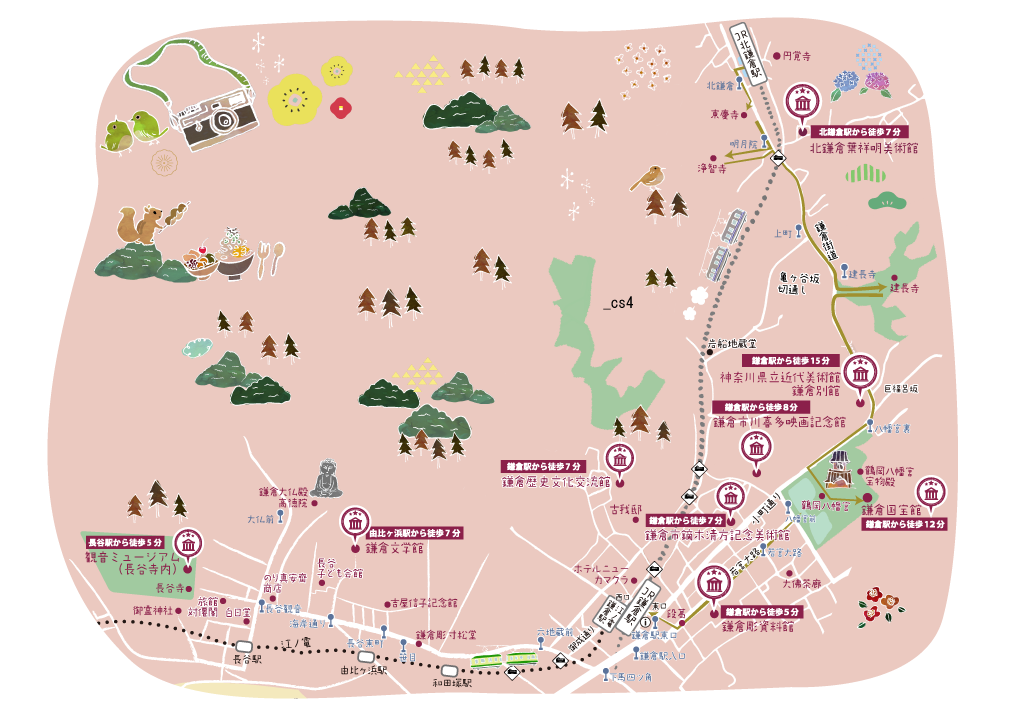
Cultural treasure rambles
Touring Statues of the Buddha (Kita-Kamakura Station area)

- Kita-Kamakura Station
- 4 minutes-walk
- Tokeiji Temple①
Seated statue of Shaka, the historical Buddha - Tokeiji Temple②
Standing statue of the Sacred Kannon Bodhisattva - Tokeiji Temple③
Water-Moon Kannon Bodhisattva, in half-lotus position- 3 minutes-walk
- Jochiji Temple
- 9 minutes-walk
- Kenchoji Temple
- 16 minutes-walk
- The Kamakura Kokuhoukan Museum
- Kamakura Station
 Kita-Kamakura Station Start
Kita-Kamakura Station Start
Buddhist temples were first built in Kita-Kamakura in the Kamakura period (1185-1333), and many historic images of the Buddha are extant there. How about exploring them while getting a feel for their history?
Countless women have turned to this statue, the principal object of devotion at Tokeiji, for protection.
According to a record of repairs written in sumi ink and stored inside the head of the statue, it escaped destruction in a fire that occurred in 1515. Three years later, the face was painted and the left eye inserted. The statue was completely in 1671. Initially, it is said, the pedestal had drapery folds over its front.
 minutes-walk
minutes-walk
This statue of the Bodhisattva Kannon has had a checkered fate.
It was originally the main focus of devotion at Taiheiji, a temple that had been located at the west gate to Kamakura. When the Satomi clan of Awa (now the Boso Peninsula in Chiba Prefecture) laid siege to Kamakura in 1525, the statue was stolen. Later, through the efforts of Yosan-ni, a Tokeiji nun, it was returned. The conspicuous embroidery-like design on Kannon’s robe was made of clay and attached to the statue with lacquer. That technique is seen only on sculptures made from the latter half of the Kamakura period to the Northern and Southern Courts period (c. 1250-1392).
 minutes-walk
minutes-walk
An elegant Kannon in a gracefully relaxed posture.
“Water-moon” implies a relaxed posture as though gazing at the moon reflected in the water’s surface. It was the dominant style in images of Kannon in China from the Song through the Yuan periods (960-1368). It is seen in Japan, however, only in the Kamakura area. Here Kannon’s hair and robes are rendered realistically, and beautifully. Not surprisingly, this statue has many admirers. It is enshrined in the Suigetsu-do; prior reservations are required to view it. (A special entrance fee of ¥300 applies.)


Literary stele at Tokeiji
Steles dedicated to many literary figures, including Tamura Toshiko, Shiga Mitsuko, and Takami Jun, have been installed in the Tokeiji temple precincts. Suggestion: Stroll around and explore the steles while enjoying the poems carved into them.

 3minutes-walk
3minutes-walk
Past, Present, and Future
Amida is the Buddha of the past, Shaka of the present, and Miroku of the future. This triad of Buddhas was enshrined here as the main focus of devotion in the hope that the they will hear the prayers of people spanning the three ages—past, present, and future. Their long robes, trailing at both sides, and the black platform are in the Song style transmitted from China.


A location used in Destiny: Kamakura Monogatari!
The beautiful stone steps in front of the main gate appear in the 2017 film Destiny: Kamakura Monogatari.

 9minutes-walk
9minutes-walk
Jizo Bodhisattva saves all sentient beings.
Temples with Jizo as their main focus of devotion are rare. In the past, this site was an execution ground known as Jigokugayatsu, Hell Hollow, and Shimpeiji, a temple enshrining Jizo Bodhisattva, who saves all, good or evil, was built here. Thus, when Kenchoji was later established here, Jizo continued to be the main focus of devotion.
 16minutes-walk
16minutes-walk
 Curator's recommends
Curator's recommends

This museum is full of powerful Buddhist statues—wonderful!
These statues of the Twelve Divine Generals belong, it has been pointed out, to the same group as the images in the Yakushido of Kakuonji temple. Of them, eight are from the Kamakura period and four from the Edo period. Unkei, a sculptor of Buddhist images, created the Okura Yakushido temple statues, which are thought to have set the standard for such sculptures in the Kamakura region. Those statues are no longer extant, but these Twelve Divine Generals are regarded as the earliest known copies.

 minutes-walk
minutes-walk
Search by themes
Search by areas
- Kita-Kamakura Station area
- Kamakura Station area
- Yuigahama Station area
- Hase Station area
- Gokurakuji Station area












